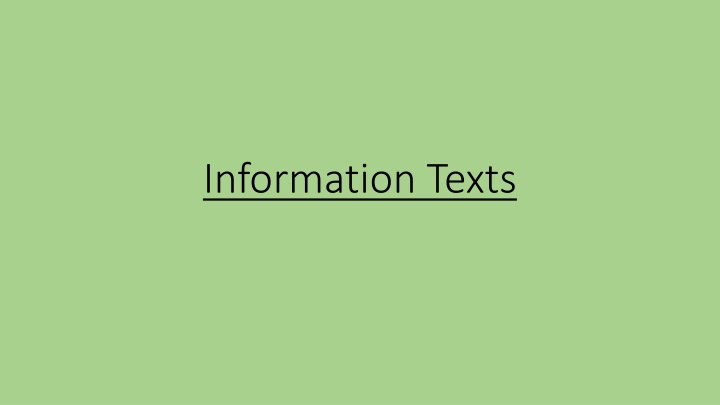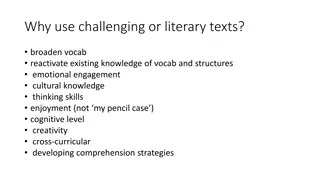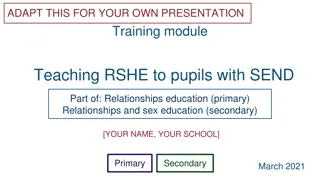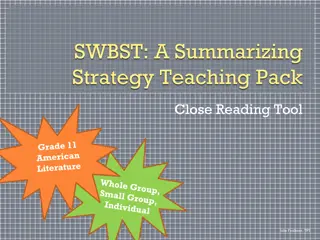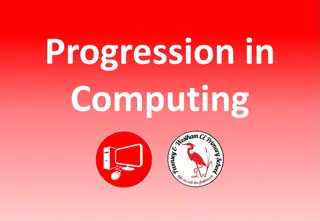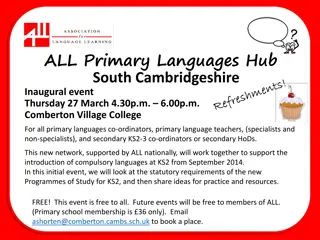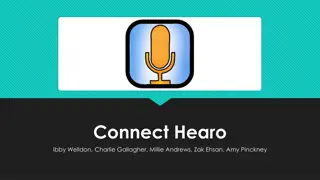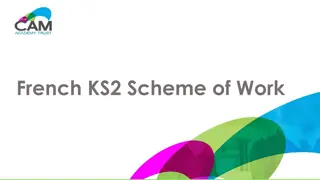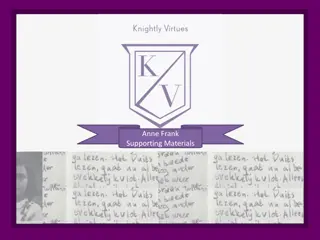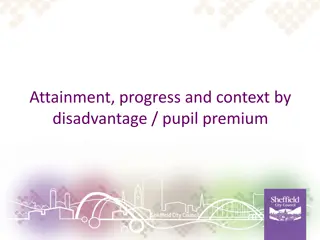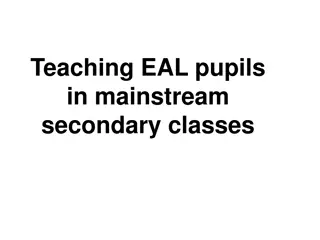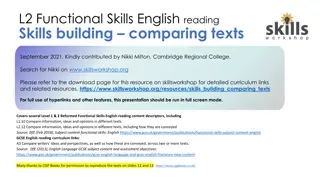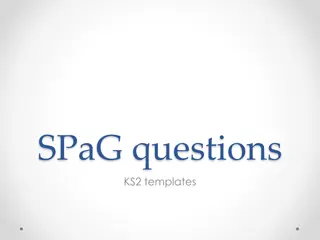Enhancing Information Texts for KS2 Pupils
Explore the key features that make an information text effective for KS2 pupils, including organization, sentence structures, punctuation, and visual appeal. Discover insights on formal tone, using technical vocabulary, images with captions, and organizing through subheadings. Dive into planning an engaging information text on the steam locomotive and George Stephenson's work with the Railway Museum in York.
Download Presentation

Please find below an Image/Link to download the presentation.
The content on the website is provided AS IS for your information and personal use only. It may not be sold, licensed, or shared on other websites without obtaining consent from the author.If you encounter any issues during the download, it is possible that the publisher has removed the file from their server.
You are allowed to download the files provided on this website for personal or commercial use, subject to the condition that they are used lawfully. All files are the property of their respective owners.
The content on the website is provided AS IS for your information and personal use only. It may not be sold, licensed, or shared on other websites without obtaining consent from the author.
E N D
Presentation Transcript
What makes a super information text? Today we are going to look at an example of an information text aimed at KS2 pupils. We re going to spot different features including: How the text is organised Appropriate sentence structures to inform Punctuation used How is the text visually appealing for the reader
Wednesday 18th November Text Analysis Subheadings showing what each section is about Stick the text in the centre of your page ready to annotate!
What did we find out about information texts? Formal tone Technical vocabulary Use of images with captions Organised through subheadings Subordinate conjunctions to begin sentences No opinions facts! Past Tense Well organised easy for reader to follow
The Railway Museum in York is updating their learning resources. They have asked pupils around the country to create information texts on the steam locomotive and the work of George Stephenson.
Planning Introduction - Impact of the railway - Life before steam locomotives - Time of change (Victorian era)
Subheadings NOTES! Sentences are banned! Who was George Stephenson? The first passenger railway Rainhill Trials and the Rocket - Personal info (think of History last week) Some info about his life before engineering - Identify technical vocabulary now - Be creative with your subheadings! Instead of Who was George Stephenson, you might call your subheading The Father Of The Railways .
Layout Devices Jot down any images you think you ll need. Think about the did you know sections (can you find fun facts and make your informative text original? Use your ipad and your green book for any additional research.
Varying Sentence Openers As you write, ensure you use a range of sentence openers. You can begin sentences with fronted adverbials and subordinate conjunctions to add variety to your writing. Subordinate Conjunctions Fronted Adverbials Other ideas! After In 1825, Many people believed Although Surprisingly, It was thought As Fortunately, Up until . Before In Victorian times, People assumed that Since During the trials, Consequently If Before long, Until Incredibly,
Your information text Audience: Purpose: Form: Style:
Introduction This should be a broad overview of the subject (railways). It should be formal and educational Try to include items from your check list Use technical vocabulary
Introduction During the 19th century (1800-1900) the development of the railway transformed Great Britain. Before steam locomotives, horse power was used to transport carriages but the invention of the steam locomotive led to huge change. For the first time, passengers could use this transport for both work opportunities and holidays. Trade across the country also improved as did the lives of the general public. The incredible expansion of the railway network is credited to George Stephenson, who was an instrumental figure in the history of transport.
The Father of the Railways George Stephenson (who was also known as the father of the railways) is renowned for his impact on the world of transportation. Stephenson was born _______ in the north of England. He pursued a career in the engineering field working as both a mechanical and civil engineer.
All Aboard! Stockton to Darlington In 1825, the first passenger carrying railway line was built by George Stephenson. It used steam power and transported the public between two small towns in the north east of England: Darlington and Stockton. Up until this event, railways were only used for goods. The first train which ran on the passenger railway was called Stephenson s Locomotive 1. Incredibly, it reached speeds of 15 miles per hour, which was unheard of at the time.
You should now have your introduction along with three paragraphs under different subheadings.
You must use bullets points in your final section! Amazing but True! Did you know George Stephenson was illiterate until the age of 18? He attended night school and taught himself to read and write as an adult. Did you know the first locomotovies Stephenson created had no breaks? They were stopped by disconnecting the engine and the gears. Did you know the first person to be killed on the railways was a member of parliament? Mr William Huskisson was knocked down by the Rocket
